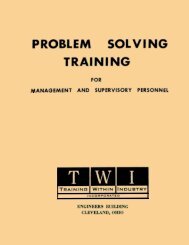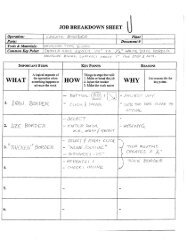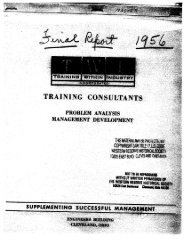Job Instruction Manual - Training Within Industry Service
Job Instruction Manual - Training Within Industry Service
Job Instruction Manual - Training Within Industry Service
Create successful ePaper yourself
Turn your PDF publications into a flip-book with our unique Google optimized e-Paper software.
52<br />
<strong>Job</strong> <strong>Instruction</strong> Plan for War Production<br />
similarly, "showing" can be brought out by concrete examples:<br />
-Showing a man hox to put plaster on a wall-it looks easy, but<br />
he puts the plaster everywhere except where it should be. It<br />
won't stick for him.<br />
-Showing a man how to tie a package and break the twine-it looks<br />
easy, but he can be most awkward in handling the package and even<br />
cut his hand trying to break the twine.<br />
-Showing a helper how to solder on sheet metal-it looks easy,<br />
but when the helper tries, everything goes wrong-sheets warp-<br />
solder won't stick, etc.<br />
Selection of proper methods for an instruction job is as important as<br />
selection of proper tools for a mechanical job.<br />
Completing a definite series of steps and operations in an instruction<br />
job is as important as following the steps outlined in an operation sheet for<br />
a shop job.<br />
Pointers on Making a Correct Demonstration of Good <strong>Instruction</strong> in Wow to Tie a<br />
Fire Underwriters' Knot"<br />
So much depends on your putting on an ideal demonstration that you<br />
should be letter perfect in carrying it out.<br />
Remember that every point you will stress later in both the breakdown<br />
and theuse ofthe four basic stepsmust be coveredby this onedemonstration.<br />
When well done, it is a background to which you can refer during the<br />
remainder of the sessions.<br />
You will have to work out exactly how to emphasize each step<br />
BE SURE to "put over" your Steps and Key Points exxtly as in the brief<br />
breakdown you will use in Session 11. Naturally you will not cover every<br />
detail as you did in your "telling" demonstration.<br />
When instructing your "worker" you may use the terms "clockwise" and<br />
"counter clockwise" or "right-hand1' and "left-handw loop, as you wish. The<br />
terms "clockwise" and "counter clockwise" are recommended: however, just<br />
because their use serves excellently to show that "peculiar, " "local, If or<br />
"tricky" terms and part names must be handled with extreme care. There are<br />
thousands of such terms throughout the shops of the country. Later in<br />
Sessions 111, IV, and V you can explain to the group that you used these terms<br />
deliberately to illustrate this point. In the breakdown in Session 11,<br />
r. h. and 1. h. are used because these abbreviations are simpler to write.









